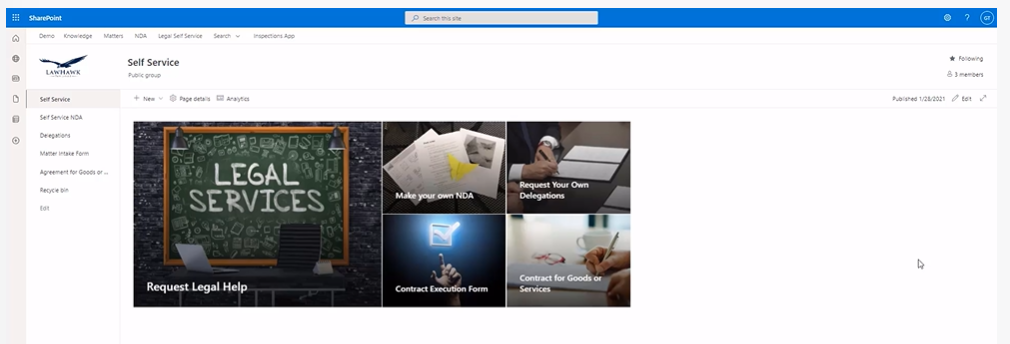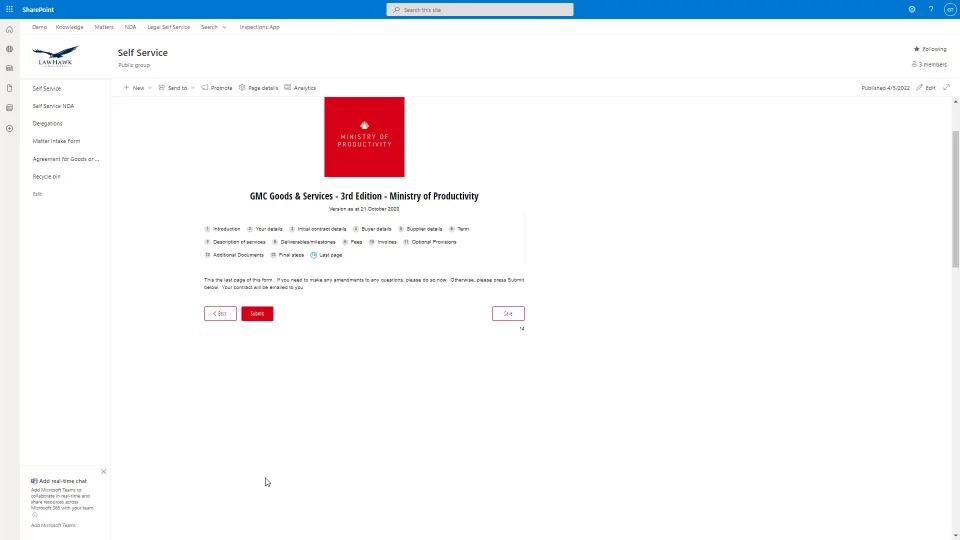
In Contract Lifecycle Management (CLM) solutions, the initial step typically involves a contract request from a business member seeking legal assistance in drafting a contract.
Without a CLM solution, these instructions are often set out in a chain of emails or a Microsoft Word document.
With a CLM solution, this process often entails filling out a digital form designed specifically for this purpose.
However, many of these contract request forms struggle to gain widespread adoption due to their limited functionality. Some of these limitations arise from the technology’s constraints. Traditional CLM solutions often rely on a flat table structure within their databases, making it challenging to handle repeated data entries—a common occurrence in contracts involving multiple deliverables, due dates, and outcomes, for example.
As a lawyer who understands the realities of contracting, I find it frustrating every time I see a CLM demo showing a contract request flowing through to an entire contract and then sending it straight to digital signing with only a handful of basic party details being completed. It’s simplistic and misleading. Where are the rest of the details about the services?!
Moreover, licensing issues further complicate matters, as increased user access to such functionality can sometimes escalate solution costs.
Recognising these obstacles, we have explored alternative options that offer greater affordability, flexibility, and alignment with the realities of the contracting process. Our investigation has centred around solutions that seamlessly integrate with the widely used Microsoft suite of products.
This post is part of a series of posts aimed at providing practical options for organisations that don’t want, can’t use, or cannot obtain a full CLM solution and are looking for guidance on what they can do with the tools they have and some reasonably priced add-ons. For more background and context, please see this introductory post.
While we initially considered the potential use of Microsoft Forms, we found that, in practice, it lacks the necessary functionality for a robust solution in this space. However, we discovered an “under the radar” alternative in Cognito Forms. This form-building solution, which does not market itself as legal tech, offers an attractive price point, allowing users to create flexible and visually appealing forms seamlessly integrating into SharePoint pages. These forms can be shared with unlimited users, whether internal or external, at no additional cost.
Upon form submission, the information can be instantly emailed to one or more recipients who can take appropriate action based on the request. However, what truly captured our attention is that Cognito Forms goes beyond being a mere request tool—it doubles as a versatile document automation solution. For simple to moderately complex contracts, business users can draft the contract themselves.
The decision of whether the contract requires legal review before it goes to the requester can be determined by conditional logic embedded within the form. The user can receive the document immediately if no red flags are triggered. However, in cases where a review is necessary, the legal team can receive the draft and take control of the process. In all cases, the legal team can retain a degree of oversight, as they can see all contracts going through the system and step in at any time if they want to.

An example of how a SharePoint, Cognito Forms, PowerAutomate, AdobeSign solution can work
What further enhances the functionality is the seamless integration of Cognito Forms with SharePoint through Power Automate. Instead of directly emailing the form from Cognito Forms, Power Automate allows the automatic saving of the document into a SharePoint library. The metadata from the form populates the respective columns in the library, effectively establishing the foundation of a contract database.
Power Automate can then analyse the submitted data and initiate approval processes using Microsoft’s built-in approvals functionality to determine if the document is ready for signing. If revisions are required, the approvals process can include links to enable live edits to the document, ensuring everyone works from the same version and can collaborate.
Additionally, Power Automate can effortlessly connect to digital signing solutions like Adobe Sign. Once approval is obtained, the document can be automatically sent out for signing. Power Automate promptly recognises the completion of the signing process and saves a signed version of the document back into the contract library, again populating all relevant metadata to reflect the contract’s status.
By combining contract requests and drafting into a more seamless process, we have witnessed the consolidation of two critical stages in the CLM process. This integration, facilitated by Cognito Forms, Power Automate, and SharePoint, offers superior functionality to traditional contract request and drafting features in more expensive CLM solutions.
If you’re interested in improving your contracting outcomes and are particularly interested in the contract request/drafting stage, please get in touch. We’ll look at your situation, and can help clarify the solutions that could work for you.
%20(1).jpg?width=290&name=Gene%20-%20December%202020%20v2%20(1)%20(1).jpg)




